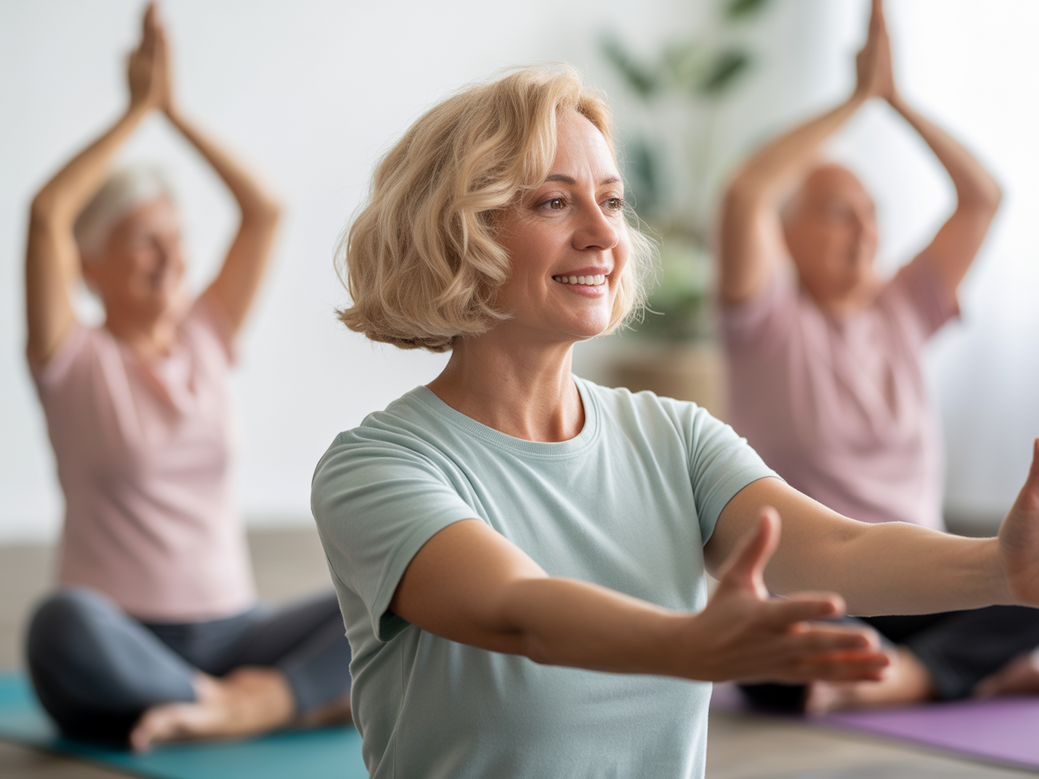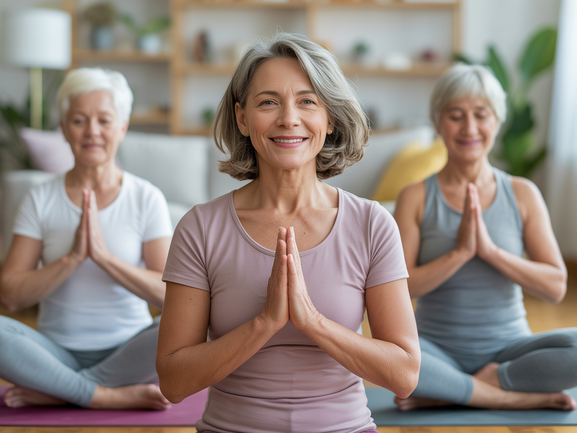Yoga for Seniors: Your Ultimate Guide to Improved Mobility and Well-being in 2025

Have you ever wondered if there’s a gentle, safe, and effective way to boost your physical and mental well-being as you age? Finding the right activity can feel like a challenge, but yoga for seniors offers a powerful and accessible solution. It’s not about complex poses; it’s a journey toward better health, and it’s more achievable than you might think.
With the guidance of an experienced instructor like Luzia, who has over 10 years of international experience, yoga becomes a truly transformative practice. Now, with the Vitalizen App | Yoga + Meditation, you can bring her expert-led sessions for yoga for seniors directly into the comfort and safety of your own home.
What Exactly Is Yoga for Seniors?
Yoga for seniors, often called gentle yoga or chair yoga, is a modified form of traditional yoga. It’s specifically adapted for older adults or individuals with physical limitations, prioritizing safety, stability, and accessibility above all else. The practice focuses on slow, deliberate movements, foundational breathing techniques (pranayama), and mindful awareness.
This approach acknowledges the body’s natural changes over time. Poses are frequently adapted using props like chairs, blocks, and blankets. These tools provide crucial support, reduce strain on joints, and ensure that everyone can participate comfortably and safely, regardless of their current fitness level or mobility. The goal is not to achieve a perfect pose but to enhance your overall quality of life through mindful movement.
The Core Benefits of Yoga for Older Adults
Embracing a regular gentle yoga practice offers a wide range of benefits that directly address the specific health concerns of older adults. It’s a holistic approach that nurtures both the body and the mind, promoting longevity and vitality.
1. Increased Flexibility and Mobility
As we age, joints can become stiff and range of motion may decrease. Gentle yoga for seniors helps lubricate the joints and lengthen muscles, making everyday activities like reaching for a high shelf, gardening, or tying your shoes easier and more comfortable. Poses like the seated Cat-Cow or gentle twists are excellent for this.
2. Improved Balance and Stability
Falls are a major concern for many seniors. Yoga is proven to improve proprioception—your body’s awareness in space. By strengthening the core and the muscles in the legs and ankles, this practice significantly enhances stability and helps reduce the risk of falls. Chair-assisted poses like Tree Pose or Warrior I are fantastic for building confidence and strength.
3. Reduced Chronic Pain and Inflammation
The slow, mindful stretching in gentle yoga can help alleviate chronic pain from conditions like arthritis or fibromyalgia. According to a 2025 report from the Journal of Geriatric Physical Therapy, regular yoga practice can lead to a significant reduction in self-reported pain. A study from Johns Hopkins University also found that yoga can improve arthritis symptoms.
4. Enhanced Mental Well-being and Cognitive Health
The powerful combination of physical movement, deep breathing, and mindfulness is proven to reduce stress, anxiety, and symptoms of depression. This practice calms the nervous system, promoting a lasting sense of peace. Furthermore, as noted by The National Institute on Aging, staying physically active is a cornerstone of maintaining cognitive health.
5. Better Sleep Quality
Many older adults experience sleep disturbances. A consistent yoga practice, especially when performed later in the day, can help regulate your sleep patterns. The calming effects on the nervous system allow you to fall asleep faster and enjoy a more restorative, deeper rest.
6. Improved Respiratory Function
The focus on controlled breathing (pranayama) in yoga for seniors can strengthen the respiratory muscles and improve lung capacity. This leads to more efficient oxygen exchange, which boosts overall energy levels and vitality.
Common Gentle Yoga Poses for Seniors (with Chair Support)
Here are a few foundational poses that are perfect for beginners. Remember to move slowly and listen to your body.
- Seated Mountain Pose (Tadasana): Sit tall in a chair with your feet flat on the floor. Lengthen your spine, relax your shoulders down and back, and rest your hands on your thighs. Breathe deeply. This pose improves posture and body awareness.
- Chair Cat-Cow (Chakravakasana): While seated, place your hands on your knees. As you inhale, arch your back and look up (Cow). As you exhale, round your spine and tuck your chin to your chest (Cat). This is excellent for spinal flexibility.
- Seated Forward Bend (Paschimottanasana): Sit at the edge of your chair. Hinge at your hips and gently fold forward, letting your hands fall toward the floor or rest on your shins. This stretches the hamstrings and back.
- Chair Pigeon Pose (Eka Pada Rajakapotasana): Sit tall and cross your right ankle over your left knee. If you feel a good stretch, stay here. For more, you can gently lean forward. This is a fantastic hip opener.
🎯 Ready to start? Start Your Gentle Yoga Journey Today with a Free 7-Day Trial on Vitalizen.
How to Start Your Yoga Journey Today
Starting your yoga for seniors journey is simple and requires just a few preparatory steps. Following a structured approach ensures your experience is positive, safe, and sustainable. Here is a step-by-step guide to begin.
- Consult Your Doctor: Before beginning any new exercise regimen, it’s wise to talk to your healthcare provider to ensure yoga is right for you, especially if you have pre-existing conditions.
- Create a Comfortable Space: You don’t need a special studio. A quiet corner in your home with enough space to stretch, free from clutter, is perfect.
- Gather Basic Props: A sturdy, armless chair is the most important prop. A yoga mat can provide cushioning under your feet, and a blanket can be used for extra support or warmth.
- Listen to Your Body: This is the golden rule of yoga. Never push through sharp pain. Learn to distinguish between the discomfort of a gentle stretch and the warning sign of pain. Modify poses as needed.
- Start with a Guided Program: Using an app like Vitalizen provides expert instruction from a qualified teacher like Luzia. This ensures you are performing movements correctly and safely, with proper alignment and modifications.
Where Can You Practice Yoga for Seniors Effectively?
The beauty of modern technology is that it brings expert guidance directly to you. The Vitalizen app is designed to make practicing yoga for seniors at home easy, safe, and enjoyable. It removes common barriers like travel, scheduling, and the intimidation of a studio environment.
- Adapted Classes: All classes, led by Luzia, are specifically designed for seniors, offering clear modifications and variations to accommodate all levels of mobility and flexibility.
- Gradual and Safe Progression: The app provides a structured program that allows you to progress at your own pace, building strength, balance, and confidence over time without pressure.
- Unmatched Convenience and Comfort: Practice yoga anytime, anywhere. All you need is a comfortable space and your smartphone or tablet to access a world of well-being.
💡 Tip: Explore the Vitalizen app with a free 7-day trial to experience the benefits of guided yoga for seniors firsthand, with no commitment!
How Much Does Yoga for Seniors Cost?
The cost of practicing yoga can vary widely. Community center classes may be low-cost, while private studio memberships can be a significant monthly investment. However, there are highly effective and affordable ways to begin.
The Vitalizen app offers a budget-friendly solution by providing unlimited access to a library of specialized classes for a low monthly fee. This is often far more economical than a single drop-in class at a studio.
| Yoga Option | Average Cost (USD/Month) | Key Advantage |
|---|---|---|
| Private Yoga Studio | $100 – $200 | In-person community |
| Community Center Class | $30 – $60 | Low-cost group setting |
| Vitalizen App | Low monthly fee (after free trial) | Convenience, safety, and affordability |
Success Stories from Vitalizen Users
“I never thought I could do yoga at 72, but Luzia’s classes on Vitalizen have been a game-changer. I feel stronger, more flexible, and more at peace. It’s the best thing I’ve done for myself in years.” – Maria
“I’ve been struggling with back pain for years, and this gentle yoga has been a lifesaver. The classes are easy to follow, and I can already feel a significant improvement in my pain levels. Thank you, Luzia and Vitalizen!” – John, 68
Frequently Asked Questions About Yoga for Seniors
Am I too old or inflexible to start yoga?
Absolutely not! It is never too late to start. A common misconception is that you need to be flexible to do yoga. In reality, yoga is the practice that *builds* flexibility and mobility safely. Gentle yoga for seniors is designed for all ages and abilities.
Is yoga safe for people with arthritis or back problems?
Yes, gentle yoga can be very beneficial for these conditions because it reduces joint stress and improves mobility without high impact. However, it’s always best to consult with your doctor first. The Vitalizen app offers classes specifically designed with modifications to ensure your safety.
What should I wear for a gentle yoga class?
Wear comfortable, breathable clothing that doesn’t restrict your movement. You don’t need fancy yoga apparel. A simple t-shirt and sweatpants or leggings are perfect. Most gentle yoga is done barefoot or with non-slip socks.
How often should a senior do yoga?
For noticeable benefits, practicing 2-3 times per week for 20-30 minutes is a great start. Consistency is more important than duration. Even 15 minutes of mindful movement a few times a week can make a significant difference in your well-being.
How can I adapt poses for my physical limitations?
This is where guided instruction is key. An experienced instructor like Luzia provides clear, step-by-step instructions and modifications for each pose, often using a chair for support. The app’s structure allows you to choose classes that match your comfort level, ensuring you can always adapt the practice to your individual needs.

